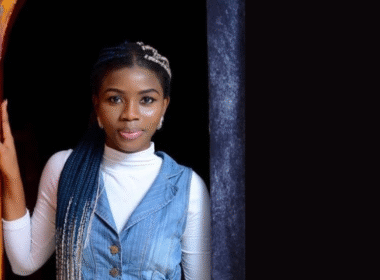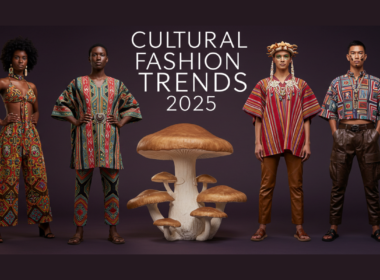Pauline Marcelle is a notable Dominican artist. She skilfully combines the intensity of modern art with the rich expressiveness of her Caribbean ancestry. Pauline studied at the University of Applied Arts in Vienna, and her paintings, which have received international acclaim, tackle issues of consumption and sustainability. Her inventive approach involves transforming digital collages into large, emotive paintings and producing sculptures with a distinct fleshy texture from discarded textiles, thereby addressing critical issues of overconsumption and waste. Continue reading to learn about her journey, creative process, and the profound stories that inspire her intriguing works.
©Lisi Specht
Pauline Marcelle From Waste to Wonder
FAB: What led you into your pursuit of sustainability?
Pauline Marcelle: I’ve been visiting Ghana since the 1990s. One day, during one of my trips, I was deeply touched by what I saw on the beach. When I visit a new country, I like to have a young local boy guide me since they know all the corners and shortcuts. One time, this boy told me we would walk to the next village, so we decided to walk. Along the way, the beach resembled a sculpture park with mysterious materials. When I asked the boy, he told me they were clothes.
We approached closer, and the beach was filled with little mountains, moulds, and sculptures made of discarded clothes, shoes, fishermen’s nets, and natural debris. It was mesmerising visually, but deeply disturbing to the soul. I realised that European companies, including the ones I supported, were part of this problem. I was contributing to this issue by buying clothes from certain brands, where garments lose their shape after a few washes.
This experience made me reflect on my habits, leading me to start upcycling. I wanted to address my own contributions to this global problem. I began this work in 2007, creating sculptures from my own clothes, which marked the beginning of my sustainability journey. This practice gave me a sense of identity and responsibility. Even if I wanted something new, I would tell myself no. I started frequenting second-hand shops to hand-pick pieces for upcycling, which I call the “Bend-Down Boutique” series. In Nigeria, this term refers to how clothes are laid out on the ground for people to bend down and pick up.
Before making sculptures, I remove the labels from the clothing’s necks and sew them together. This ongoing project has become a lifelong piece. I didn’t realise how significant labels were to people until some refused to give me theirs. People, especially those who are fond of designer labels, are deeply connected to these tags. Removing them affects their perception of the garment.
©Lisi Specht
More Like This:
2024: The Year of Earth-Healing Habits
FAB: What was the creative process behind telling this story in your work?
Pauline Marcelle: My initial focus was on paintings and depicting just the clothing. I wanted to highlight the raw aspects of the materials. I started taking pictures of abandoned clothing and then used those images to create new clothing within my paintings. For instance, I would make a shirt from a completely different material or pattern inspired by the debris. From these inspirations, I created digital collages and even digital textiles with debris patterns, turning them into wallpaper designs. Whenever I have a concept, I think about which art form would best convey it, making me more conscious of the materials I use and the story I want to tell.
FAB: Is there any symbolic or metaphorical significance these sculptures hold within the concept of your broader artistic narrative?
Pauline Marcelle: I aimed to reproduce something I saw on the seashore in Ghana. The abandoned clothing there looked very sculptural and weighty, which was unexpectedly moving. One of my first sculptures was a large, oversized piece made from clothing, “The Big Beat”. When making sculptures, you can create veins with the clothes, making them look very fleshy. I’ve also created pieces representing internal organs like the spleen, which are all blood-red. Another piece is a blue sculpture, “Blue Venus”, with a shell formation covered in clothing, symbolising the clothing in the sea and not just on the shore. During the pandemic, I created a piece called “It’s not over yet” using clothes from my family and friends, symbolising connection and shared experience.
FAB: How do your colour choices contribute to the emotional and psychological impact of your work?
Pauline Marcelle: Coming from a small island with limited resources, we had to save and use what was available, which influenced my colour choices. I’ve always painted with colours that were accessible, often mixing primary colours to get the desired shades. For instance, mixing yellow and blue to get green reflects the lush greenery of my homeland. As a child, I thought green would overshadow my paintings, so I chose bold colours instead. Now, I feel a green series would reconnect me with the verdant landscape of my youth. The colours I use are universal; if I relied on special mixes that aren’t available everywhere, my work wouldn’t have the same universal appeal. In Johannesburg, I struggled to find a specific blue mix and realised the importance of sticking to primary colours that I can mix and create anywhere.

Art can be incredibly therapeutic. It helps me understand the truths and lies of the world, allowing me to dissect and process them. I strongly believe we can heal through art.
Pauline Marcelle
FAB: What intriguing thing do you see in society today that you might like to work on?
Pauline Marcelle: I think the world needs healing, and it’s something I observe everywhere. Whether I’m in the Caribbean or back in Austria, I see people behaving similarly and reacting to circumstances in the same ways. I’m intrigued by how people manage their social lives and how they get along in similar situations. This realisation makes me very conscious of the people I meet, who I spend time with, and what I consume. I’ve done a series called “The Catharsis” and am currently in a healing stage myself. I’m also working on a short series that delves into the shadows of my ancestors.
FAB: Can art truly be a vehicle for healing?
Pauline Marcelle: Absolutely. Art can be incredibly therapeutic. It helps me understand the truths and lies of the world, allowing me to dissect and process them. When you have a theme in art, you need to feel and dissect its content, which mirrors how we should approach our daily lives. Art helps me a lot; it allows me to weigh and examine myself. I strongly believe we can heal through art.
FAB: Have you faced any backlash or criticism from the audience or collectors?
Pauline Marcelle: Fortunately, I haven’t faced much backlash. Most people resonate with the idea and acknowledge that they are part of the problem. When I started this journey in 2006/2007, people didn’t appreciate the ‘ugliness’ of the concept and struggled to deal with it. However, as these issues have become more prominent in the media, people have come to embrace the idea more than before. This acceptance feels normal now.
©Lisi Specht
FAB: How do you hope your work will be remembered in the context of contemporary art?
Pauline Marcelle: In my country, we have a small pool of artists. Coming from a tiny nation with just 60,000 people, I’m dedicated to using my art for the benefit of my country. I hope young people will embrace art more passionately. I’ve always wanted to make a sacrifice for my country through my artistic endeavours. Interestingly, we are all connected; my brother researched our ancestry and found Nigerian roots. For perspective, our entire country’s population is comparable to that of a village in Nigeria. We lack an art institute to support us, so we have to do everything ourselves. It’s not easy to be an artist in my country due to the limited resources available.
My dream is to help elevate the art sector in my country and be a significant example for the Caribbean region. When kids grow up and take to the streets, I want them to know there’s an alternative to drugs. Our drug problem is pervasive, and my goal is to keep our youth safe and aware of the possibilities around them.

Fun Zone: #FABFastFive
FAB: What is your favourite childhood book?
Pauline Marcelle: Anansi (the spider story)
FAB: If you had the opportunity to be immortal, would you take it?
Pauline Marcelle: Yes. My art is immortal.
FAB: What is that one song that makes you sing along whenever you hear it?
Pauline Marcelle: At the moment, Praise Jah in the morning from YG Marley.
FAB: What’s your favourite thing to do on a weekend?
Pauline Marcelle: I like to spend time with my family.
FAB: If you could create art with any artist in the world, who would that be?
Pauline Marcelle: Basquiat and his Creole roots
Image Credit: Sunla Mahn | Lisi Specht
Fashion Design Studio 343 Graduation Show – Tina Zsapka, Jaroslava Poliaková


















